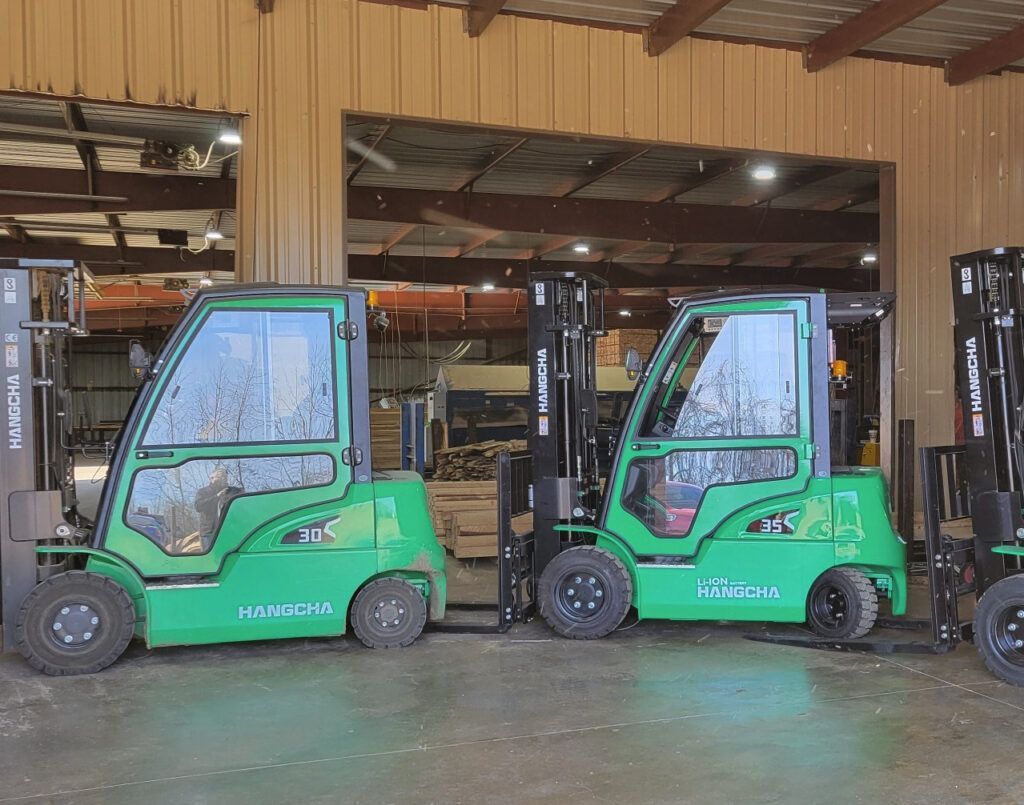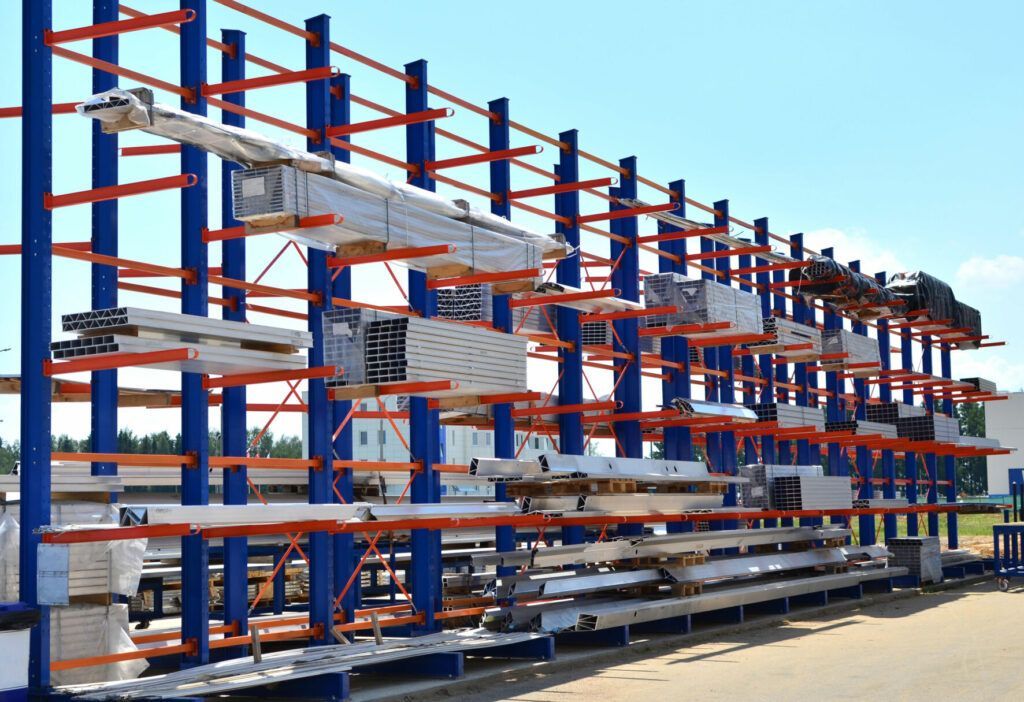A Beginner’s Guide to Electric Forklifts
Efficient material handling is crucial for businesses of all sizes and industries. It directly impacts productivity, cost-effectiveness, and overall operational success. Effective material handling ensures that goods are moved, stored, and transported in a streamlined and organized manner, minimizing delays, damages, and errors.
Electric forklifts play a significant role in effective material handling, transforming the industry since their inception. This blog explores these machines’ benefits, use cases, and considerations. First, though, is a quick refresher on the different types of forklifts.
Types of Forklifts Used in Material Handling
Forklifts come in various types, each designed to suit specific material handling needs. The most commonly used forklifts in material handling operations include counterbalance forklifts, reach trucks, pallet jacks, and order pickers.
- Counterbalance Forklifts: These forklifts weigh the back to counterbalance the weight of the lifted load, eliminating the need for additional support. They are versatile and are operable indoors and outdoors, making them ideal for various material-handling tasks.
- Reach Trucks: The design of reach trucks makes them efficient in narrow aisles and tight spaces. They feature extended forks and a mast that can reach high heights to retrieve or store materials on high shelves.
- Pallet Jacks: Pallet jacks, also known as pallet trucks, are used for moving palletized loads over short distances. They are manually operated and commonly found in warehouses, supermarkets, and distribution centers.
- Order Pickers: Order pickers do just that: pick individual items or small quantities from shelves. They typically have a platform on which the operator stands and can lift the operator along with the load.
Advantages of Electric Forklifts in Material Handling
Electric forklifts have gained popularity in recent years due to some key advantages over their diesel or gas-powered counterparts.
- Eco-Friendly: Electric forklifts produce zero emissions, making them environmentally friendly. They are an excellent choice for businesses looking to reduce their carbon footprint and comply with stricter emission regulations.
- Reduced Operating Costs: Electric forklifts have lower operating costs than diesel or gas-powered ones. They require less maintenance, have fewer moving parts, and do not require fuel or oil changes. Over time, these cost savings can significantly impact a business’s bottom line.
- Lower Noise Levels: Electric forklifts operate quietly, which is particularly beneficial in noise-sensitive environments such as hospitals, schools, and residential areas. Reduced noise levels contribute to a more pleasant and productive work environment by helping to minimize audible distractions.
- Improved Maneuverability: Electric forklifts are known for their excellent maneuverability. They have a smaller turning radius, allowing them to navigate through narrow aisles and tight spaces easily; this enhances efficiency and reduces the risk of accidents or damage to goods and infrastructure.
Safety Precautions for Operating Electric Forklifts
While electric forklifts offer many benefits, it is essential to prioritize safety by following some crucial safety precautions.
- Proper Training: Operators should receive comprehensive training on operating electric forklifts safely; this includes understanding the controls and load capacity, and performing routine inspections and maintenance.
- Regular Inspections: Electric forklifts should undergo regular inspections to ensure they are in good working condition. Team members should check for wear and tear, test the brakes, and inspect the battery and charging system.
- Safe Load Handling: It is crucial to adhere to the recommended load capacity of the electric forklift. Overloading the forklift can lead to instability and accidents. Properly securing and balancing the load is also essential to prevent shifting during transportation.
- Surroundings Awareness: Operators must always be aware of their surroundings and watch for pedestrians, obstacles, and other hazards. Clear signage, designated pedestrian areas, and proper lighting can significantly improve safety in the workplace.

Best Practices for Maximizing Efficiency in Material Handling with Electric Forklifts
To maximize efficiency in material handling with electric forklifts, consider implementing the following best practices:
- Optimize Warehouse Layout: Design your warehouse layout to minimize travel distances and congestion. You can strategically place frequently accessed items closer to the entrance and organize the storage areas based on the frequency of use.
- Implement Inventory Management Systems: Utilize inventory management systems to track and manage stock levels in real-time; this helps prevent stockouts, enables more accurate demand forecasting, and streamlines the order fulfillment process.
- Use Advanced Forklift Attachments: Invest in specialized forklift attachments such as clamps, side shifters, and rotators to enhance the versatility and efficiency of your electric forklift. These attachments enable handling different types of loads and reduce the need for manual labor.
- Train and Empower Employees: Provide ongoing training and empower your employees to make suggestions for process improvement. They are the ones working on the front lines and often have valuable insights into how material handling can be optimized.
Choosing the Right Electric Forklift for Your Business Needs
When choosing an electric forklift for your business, consider the following factors:
- Load Capacity: Determine the maximum load capacity required for your material handling operations. Consider both the average load weight and any potential future growth in your business.
- Operating Environment: Assess the operating environment, including the terrain type, temperature variations, and special requirements. Some electric forklifts are better suited for indoor use, while others are designed to handle rugged outdoor conditions.
- Battery Life and Charging: Evaluate the electric forklift’s battery life and charging capabilities. Consider the battery’s runtime, the required charging time, and the charging infrastructure availability in your facility.
- Manufacturer Reputation: Research and choose a reputable manufacturer known for producing high-quality, reliable electric forklifts. Read customer reviews and seek recommendations from industry professionals to make an informed decision.
Maintenance and Servicing of Electric Forklifts
Proper maintenance and servicing of electric forklifts are essential to ensure their longevity and optimal performance. Follow these maintenance practices:
- Regular Inspections: Conduct routine inspections to identify potential issues before escalating. Check for fluid leaks, loose connections, worn-out tires, and any signs of damage or malfunction.
- Battery Maintenance: Follow the manufacturer’s guidelines for battery maintenance, including regular cleaning, checking the water levels, and ensuring proper charging procedures.
- Scheduled Servicing: Adhere to a scheduled servicing plan to address any necessary repairs, replacements, or adjustments. Make a checklist for your team, which includes regular oil changes, filter replacements, and lubrication of moving parts.
- Operator Feedback: Encourage operators to report any abnormalities or concerns regarding the electric forklift. Their feedback can help identify and address potential issues before they cause significant breakdowns or accidents.

Work With Benco Industrial Equipment
Embracing electric forklifts in material handling operations can transform your business’s efficiency and safety. By understanding the importance of efficient material handling, choosing the right forklift, and implementing best practices, you can take your material handling capabilities to new heights.
Here at Benco Industrial Equipment, we know the ins and outs of the materials handling industry and can help you choose the best equipment for your warehouse or project. We have both electric and IC forklifts ready to buy or rent. Are you looking for legless stackers, straddle stackers, work assist forklifts, or reach stackers? We’ve got them. We’ll keep your warehouse clean with floor sweepers, scrubbers, industrial fans, and other equipment to help your warehouse succeed. Get in touch with us today!
The post A Beginner’s Guide to Electric Forklifts appeared first on Benco Industrial Equipment.




